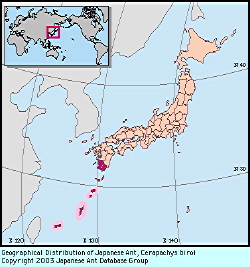
|
species
|
Cerapachys biroi
|
 |
Japanese Name
|
Kubire-hari-ari
|
Original Reference
|
|
Forel, A. (1907) Formicides du Musˇe National Hongrois. Annales HistoricoNaturales Musei Nationalis Hungarici 5: 1-42.
|
Synonym
|
|
Cerapachys (Syscia) silvestrii Wilson & Taylor (Wilson & Taylor, 1967) ,
Syscia typhla Sonobe (Sonobe, 1973) ,
|
Description
|
|
Total length of workers about 2.5 mm. Color reddish brown. Antennae 9-segmented. Body surface densely covered with fine punctures and short pale hairs. Eyes absent. Pronotum weakly marginate anteriorly. Petiole almost as long as wide, node rounded; subpetiolar process distinct, projecting ventrally and curved posteriorly. Constriction between 1st and 2nd gastral segments distinct. Second gastral segment elongate, longer than total length of petiole + 1st gastral segment.
|
Remarks
|
|
A widespread tropical and subtropical species. In Japan, C. biroi occurs in the Nansei Islands, and is found on the floor of broad-leaved forests, nesting in soil or under stones. Colonies may include a few hundred workers and ergatoid queens.
|
|

Distribution
|
|
Nansei Is (Amami-oshima I. and southwards); Mainland China, Taiwan, SE Asia, India, Polynesia, West Indies.
|
|
Editor
|
|
Original text Kazuo Ogata and Mamoru Terayama. English translation by Kazuo Ogata, edited by Robert W. Taylor.
|
|